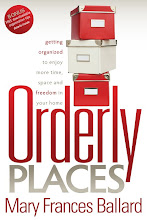Illustration from marthastewart.com
There are two
areas that benefit from organizing in August: school and office.
Many states have a weekend of freedom from sales tax to help with school supplies. Many office and stationery supplies are covered, too. These stores will identify covered items for you. In
Most stores have increased their inventory of school and office supplies. You can find a better selection and better prices this month. Make a list and try to find those things you need while there are good choices. Plan ahead for consumable items like printer paper, notepads, etc. Be sure you have room to store these items. For children, check the supply list created by the specific school or teacher.
Clean out stationery and office items
that are no longer useful or in disrepair. Organizing your
files is a great indoor activity when the weather is too hot for outside
work. Look for free shredding events in your area to
dispose of confidential papers without burning up your shredder. We have personal experience in that activity!
Think
ahead in purchasing children’s clothing. My oldest child grew 3” the first two months of his 9th
grade year. The clothes I purchased early in August to get the best selection w ere too small in October. (This was before long baggie
pants were acceptable.)
If you plan on having a yard sale in the fall, begin planning now. Start gathering items that you need to move on, clean and price them. Young children have probably outgrown last year’s school attire. Take an inventory to see what you can sell or donate now. As colder weather and winter approach, you may need to take another look at heavier clothing to see what can be eliminated.
Go to Craig’s list or EBay to determine a reasonable price for selling your items. In fact, you may want to put some of the items up for sale on those sites now so they won’t take up storage space in your home. If you want to join w ith
others in a sale, pick a date now that is good for everyone. Remember, you can always donate items to a local thrift store or charity and possibly bless someone less fortunate. It is good to pay forward.
If you plan on having a yard sale in the fall, begin planning now. Start gathering items that you need to move on, clean and price them. Young children have probably outgrown last year’s school attire. Take an inventory to see what you can sell or donate now. As colder weather and winter approach, you may need to take another look at heavier clothing to see what can be eliminated.
Go to Craig’s list or EBay to determine a reasonable price for selling your items. In fact, you may want to put some of the items up for sale on those sites now so they won’t take up storage space in your home. If you want to joi




